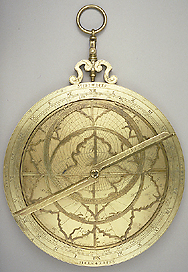
 |
| Catalogue |
 |
 Astrolabe The throne consists of two raised foliate scrolls with an inset swivel pin. The rete has a complete equatorial circle ; the star pointers resemble flames ending in a small circle. The names of 38 stars are given, mostly with their magnitudes and corresponding planetary temperaments. The ecliptic is marked with the usual Latin names for the zodiacal signs and their symbols. Each sign is divided into 30? numbered by 10?, divided into 5? and subdivided into single degrees. The equator has a 360? scale starting at the first point of Aries anticlockwise, numbered by 10?, divided by 5? and subdivided into single degrees. The three plates are marked on both sides with the circles for the equator (marked 'Aequinoctialis') and the tropics (marked 'Tropicus Cancer' or 'Cancri' and 'Tropicus Capricorni'), azimuths for every 5? (numbered by 5?), almucantars for every 5? (numbered by 5?), the lines for the unequal hours (numbered 1 to 12), markings for the astrological houses in the manner of Regiomontanus (numbered I to XII), the 'Horizon obliqus' and the 'HORIZON RECTUS' and the twilight curve (marked 'LINEA AVRORE SIVE CREPVSCOLINE'). The sides are marked and laid out for the following latitudes ('Latitudo Graduum'): 1a) 35?; 1b) 38?; 2a) 42?; 2b) 45?; 3a) 48?; 3b) 51?. One plate appears to be missing. The back of the instrument bears several circular scales as follows (from the outside): 1) A concentric 360? altitude scale, marked four times 0? to 90? starting on the east-west line in both directions, numbered by 5?, subdivided to single degrees. 2) A concentric scale with the usual Latin names of the zodiacal signs, their symbols and the corresponding planetary house. Each sign is divided into 30?, numbered by 5? and subdivided to single degrees. 3) An eccentric calendar scale marked with the usual Latin names of the months, divided into the corresponding number of days, every fifth day marked, with subdivisions into single days. The equinoxes correspond to March 21 and September 23. To fill the space between the concentric circle and the eccentric circle there are several circles on both sides of scale 3). The bottom half of the vacant space inside these circles is taken up by a double shadow scale marked 'VMBRA VERSA' and 'VMBRA RECTA' to the bases of 12 and 60, with divisions into 2 and 10 digits (every second and every tenth digit respectively numbered) and subdivisions into single and 0.2 digits. On the inside of the shadow scale is the signature 'Cornelio Vinchx Fiamengo Damuer Faecebat 1600'. The space outside the shadow square is filled with a floral design with strapwork and birds. The top half contains a double horary quadrant for unequal hours, marked I to XII. Inside the midday circle is a wreath surrounding the coat of arms of the Gonzaga and the inscription 'CAMILLUS GONZAGA COMES NOVELLAR'. The rule (marked 'INDEX' on one arm) is counterchanged and marked with an irregular scale 70? to 0? to 30?, every 10? numbered, divided to 5? and subdivided to single degrees. The counterchanged alidade has a foliate decoration; the sighting vanes are missing. The instrument, formerly in the Spitzer collection, was purchased in 1893. It is described in F. A. B. Ward, A Catalogue of European Scientific Instruments in the Department of Medieval and Later Antiquities of the British Museum (London, 1981), p. 118, no. 341. Silke Ackermann |



